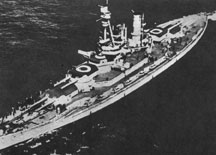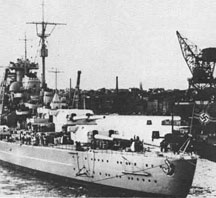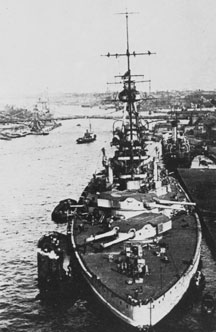| Baden to Bismarck:
A Story of Stagnation
By Mike Bennighof, Ph.D.
November 2020
When the German Kriegsmarine launched the
battleship Bismarck in February 1939, Nazi
propagandists proclaimed her a technical marvel.
And while she was a well-built ship, many
of her innovations are, like other things that
“everybody knows” among history
buffs, simple myth. In many ways she was less
advanced than American, Japanese, Italian
or British battleships of the same time.

The old: Imperial battleship Bayern.

The new: Nazi battleship Bismarck.
|
Prior to Bismarck and her sister Tirpitz, the last true battleships completed in
Germany were the two Bayern-class dreadnoughts
built for the Imperial Navy. Baden and Bayern were laid down in December 1913
and January 1914 and completed in 1916; two
slightly improved sisters, Sachsen and Württemberg, were laid down in
1914 and 1915 respectively but never completed.
German engineers had toyed with an armament
very similar to that of the American Pennsylvania class laid down within weeks of Bayern and Baden: Twelve 13.8-inch (350mm)
guns in four triple turrets. The American
ship carried a dozen 14-inch guns. A German
team had inspected the Austrian Viribus
Unitus with its four triple turrets and
came away unimpressed with Austrian battleship
design in general and the triple turret in
particular (Austrian engineers on a reciprocal
visit had equally scornful comments about
the turret arrangements of German dreadnoughts).
The middle gun, the Germans believed, would
have a markedly lower rate of fire and in
case of an unlucky hit to the turret, the
ship would lose three guns rather than two.
A bigger turret also created a larger opening
in the hull, weakening the ship’s structure.
When word arrived that the British would
go to a 15-inch gun for their new battleships,
the German admirals decided to skip the intervening
caliber and go from 12-inch to 15-inch guns
for their new battleships. Bayern followed
the same general layout as the British Queen Elizabeth class laid down about a year earlier:
eight 15-inch guns in four twin turrets, two
of them forward and two aft, in superfiring
pairs (one turret mounted above and behind
the other). Bayern had 11 coal-fired
and three oil-fired boilers, a mixed power
plant first adopted for the Derfflinger class battlecruisers a year earlier.
Bayern was the last battleship design
actually built by Imperial Germany, though
design work continued on a number of projects
that could not possibly be built until after
the war. Had the Germans laid down a new class
of battleship in 1916, it would have been
a repeat of the Bayern class.
 
The new designs for the post-Bayern battleship
class featured a new 16.5-inch (420mm) gun;
like the 13.8-inch gun this was a Skoda design
licensed from the Austrian firm. They were
much larger than Bayern, and like the Mackensen class battlecruisers featured
one large funnel. Internal arrangements —
armored citadel, magazines, boiler rooms —
were very similar to Bayern.
When Reichsmarine enginners began preliminary
work on a new class of true battleships in
1932, they picked up where the Imperial staff
had left off. Formal contracts for the design,
and for 15-inch and 16-inch naval guns, went
out in 1934. Germany laid down a pair of battle
cruisers in 1934, Scharnhorst and Gneisenau, with 11-inch guns to adhere to the Versailles
Treaty limit on German warship armament and
thus help bolster German chances in the negotiations
that would lead to the Anglo-German Naval
Treaty a year later. These two ships were
designed so that the triple turrets for 11-inch
guns could be replaced by twin turrets holding
15-inch guns at some later date.

Baden just after commissioning,
1916.
|
The 15-inch, 47-caliber guns for those turrets
were an improvement on the 45-caiber weapons
carried by Bayern, borrowing some technical
characteristics from the 50-caliber guns built
by Ansaldo for the Littorio class in
Italy. Despite some fanciful claims by later
writers, these guns had no magically fast
rate of fire and slightly less range and penetrating
power than the Ansaldo gun. Gunnery practice
would show that Bismarck had a main battery
rate of fire of about two rounds per minute
— about standard for all World War II
battleships, though many American crews did
better.
Initially set at 35,000 tons, the new design
(“Battleship F,” only later named Bismarck) followed very conservative
lines. The engineers drew heavily on Bayern and on the never-built L20 and L28 designs. Bismarck shared the armament layout
of Bayern; with Bayern, German
naval author Siegfried Breyer wrote in 1970,
“the battleship as a type had reached
its peak of perfection. Any improvements during
the subsequent twenty years concerned only
details and not the actual design of the type
of ship.” The biggest difference in
armament came in the secondary battery; where Bayern carried her sixteen 5.9-inch
guns in a casemate battery (similar to L20
and L28), Bismarck had a dozen in six
twin turrets.

Bismarck’s aft main battery.
|
Just as the L20 series had an outdated secondary
battery (Italian designers were already placing
secondary guns in turrets), so did Bismarck. Other navies, especially the Americans,
were mounting dual-purpose secondary guns
on their new battleships. Germany lacked such
a weapon, and design concepts seem to have
lagged behind that of other nations as well,
and so Bismarck carried two different
types of secondary gun — the 5.9-inch
battery for surface targets, and sixteen 4.1-inch
(105mm) anti-aircraft guns. While L28 carried
her 5.9-inch guns in casemates, she did have
four turrets for 105mm or 88mm anti-aircraft
guns (this detail differs in some sketches),
though in single mounts.
While there is a superficial resemblance
between Bayern and Bismarck, the
real similarities are under the skin. Both
ships had nearly identical three-shaft machinery
layouts. The higher speeds demanded
for Bismarck resulted in a much longer
ship, both to allow much finer lines and to
house a much larger power plant: 138,000 horsepower
for Bismarck against 48,000 for Bayern. The dozen huge boilers also resulted in
a ship that drank fuel at a prodigious rate; Bismarck had a relatively short radius
of action, a flaw shared with the older Imperial
designs.
Magazine layouts were also nearly identical
between the two ships, another sign of heavy
borrowing by Bismarck’s designers.
Where they differ is in their bridge arrangement,
but here also Bismarck’s designers
drew on earlier work. Werner Fuchs, the Germany
navy’s head of construction, demanded
that all heavy ships share a similar appearance,
thinking this would confuse enemy spotters.
Features included a heavy foremast for the
fire control director and a single large funnel. Bismarck’s upper works, like
that of Scharnhorst and the Admiral
Hipper class cruisers, was based not on Bayern but on L28.

Bayern’s aft main battery.
|
Bismarck and Bayern also shared
strong internal protection, and were well-built
ships (though British engineers had been rather
scornful of the Bayern class in post-war
testing). Their armor schemes were very similar,
with Bismarck sporting thicker deck
armor but a thinner armored belt than Bayern.
Bismarck crept well over the 35,000-ton
figure, but by the time she launched the “accelerator
clause” of the London Naval Treaty had
kicked in and the upper limit had gone to
45,000 tons. Though Bismarck and her
sister were the largest battleships ever completed
in a European shipyard, they were within the
limits set by international agreements and
much smaller than the huge Japanese Yamato class or even the American Iowa class.
Bayern and her sisters appear in Great War at Sea: Jutland, and further Imperial designs in Jutland 1919. Bismarck of course is the centerpiece
of the
game bearing her name.
Click here to order Great War at Sea: Jutland now!
Click here to order Second World War at Sea: Bismarck now!
You can order Jutland 1919 right here.
Sign up for our newsletter right here. Your info will never be sold or transferred; we'll just use it to update you on new games and new offers.
Mike Bennighof is president of Avalanche Press and holds a doctorate in history from Emory University. A Fulbright Scholar and NASA Journalist in Space finalist, he has published countless books, games and articles on historical subjects.
He lives in Birmingham, Alabama with his wife, three children and his dog, Leopold. Leopold is an original design.
Want to keep Daily Content free of third-party ads? You can send us some love (and cash) through this link right here. You don’t have to, but Leopold would like it if you did.
|
